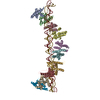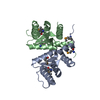+Search query
-Structure paper
| Title | Cooperative DNA Binding of the Plasmid Partitioning Protein TubR from the Bacillus cereus pXO1 Plasmid. |
|---|---|
| Journal, issue, pages | J Mol Biol, Vol. 430, Issue 24, Page 5015-5028, Year 2018 |
| Publish date | Dec 7, 2018 |
 Authors Authors | Ikuko Hayashi / Takashi Oda / Mamoru Sato / Sotaro Fuchigami /  |
| PubMed Abstract | Tubulin/FtsZ-like GTPase TubZ is responsible for maintaining the stability of pXO1-like plasmids in virulent Bacilli. TubZ forms a filament in a GTP-dependent manner, and like other partitioning ...Tubulin/FtsZ-like GTPase TubZ is responsible for maintaining the stability of pXO1-like plasmids in virulent Bacilli. TubZ forms a filament in a GTP-dependent manner, and like other partitioning systems of low-copy-number plasmids, it requires the centromere-binding protein TubR that connects the plasmid to the TubZ filament. Systems regulating TubZ partitioning have been identified in Clostridium prophages as well as virulent Bacillus species, in which TubZ facilitates partitioning by binding and towing the segrosome: the nucleoprotein complex composed of TubR and the centromere. However, the molecular mechanisms of segrosome assembly and the transient on-off interactions between the segrosome and the TubZ filament remain poorly understood. Here, we determined the crystal structure of TubR from Bacillus cereus at 2.0-Å resolution and investigated the DNA-binding ability of TubR using hydroxyl radical footprinting and electrophoretic mobility shift assays. The TubR dimer possesses 2-fold symmetry and binds to a 15-bp palindromic consensus sequence in the tubRZ promoter region. Continuous TubR-binding sites overlap each other, which enables efficient binding of TubR in a cooperative manner. Interestingly, the segrosome adopts an extended DNA-protein filament structure and likely gains conformational flexibility by introducing non-consensus residues into the palindromes in an asymmetric manner. Together, our experimental results and structural model indicate that the unique centromere recognition mechanism of TubR allows transient complex formation between the segrosome and the dynamic polymer of TubZ. |
 External links External links |  J Mol Biol / J Mol Biol /  PubMed:30414406 PubMed:30414406 |
| Methods | SAS (X-ray synchrotron) / X-ray diffraction |
| Resolution | 2 Å |
| Structure data |  SASDEH3:  PDB-6aht: |
| Chemicals |  ChemComp-HOH: |
| Source |
|
 Keywords Keywords | TRANSCRIPTION / plasmid segregation |
 Movie
Movie Controller
Controller Structure viewers
Structure viewers About Yorodumi Papers
About Yorodumi Papers




